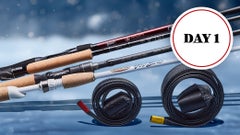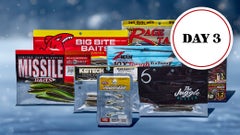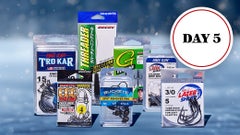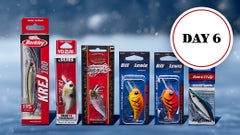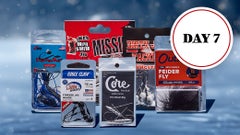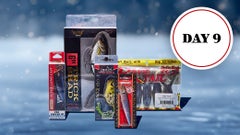Casey Smith Wins Potomac River FLW Series
Smith's victory can be traced to a decision he made on day 2. He went into the tournament planning to target scattered grass around the mouth of Aquia Creek and then follow the incoming tide north for the rest of the day. On day 1, he had four fish for roughly 13 pounds in the boat by 8:15 a.m., all on a swimbait. "It was a great start," he said. "Things were rolling good." He encountered a lull as the tide went slack and he stuck around the area too long trying to finish his limit. He wound up catching a 1 1/2-pounder, but he regretted not sticking to his plan. "I stayed too long trying to force it," he added, and that put me behind the 8 ball trying to run the tide back north. I felt with the start I had and the 4 good ones I had, I was disappointed. I lost a 3 1/2-pounder that would've culled that small one." On Friday, as he came out of Mattawoman Creek, he hadn't decided if he was going back to his day-1 starting area of if he was going to head north right away. A north/northeast wind had blown into his spot on day 1 where he caught his first four fish. "I debated going back there on day 2," Smith said. "I knew it would be tough, but I knew the quality was down there." Ultimately, he made the call to go south. The wind wasn't as bad as he thought it'd be. "Even if we got down there an it wasn't fishable, there was still time to go north and hit the good tide," he said.
Smith got on a flurry right away and had a limit pretty quick. The good start settled his nerves and reassured him he'd made the right call. "I had a time when I was leaving that area no matter what, but as I fished around, I kept getting bites and making small upgrades," he said. "On Thursday, when the flurry ended, it was over. On Friday, the wind and clouds kept those fish active and kept me there. "I knew it was a risk again, but with the fish I was catching, I knew I was keeping myself in check range and possibly in contention to make the top 10." When the tide went slack, the bites stopped, but as soon as the tide started coming in, "the big ones started to fire," Smith added. "I started to culling out 2- to 2 1/2s with 3 3/4- to 4 3/4-pound fish. That's when I realized what was going on. I realized there was a morning bite and in the afternoon, when tide switched, the bigger fish became active." He wound up bagging a tournament-best 20-00 that put him in the lead entering the final day.
Smith opted to follow the same plan as day 2 on the final day, but he knew he'd have a much shorter window in the afternoon due to an earlier check in time and the better tide conditions being an hour later. "I had from 12:30 until 1:45 or 2, at the latest," he said. "I was going to try to capitalize on the morning flurry and wait out the dead period." He caught everything he eventually weighed by 9:15 a.m., highlighted by a 6-pounder. "After that, it shut down because there was no wind or clouds," he said. "It got sunny and slick." He continued to fish the area, which had been inundated with local anglers. He eventually left for about 90 minutes and returned only to find Charlie Macheck fishing the spot. "We had to communicate as best we could and work around each other," Smith said. "During what I felt was the good window, my co-angler caught a 4 1/2, Charlie caught two big ones and I didn't catch anything. "I was stressing when Charlie and I were communicating. I knew he had a good bag and he caught those two upgrades. I knew I was close. I knew everybody had to catch something, but I knew I didn't close it out."
Winning Pattern:
The area Smith referred called his "winning area" was a grass flat outside the mouth of Aquia Creek. "There were a mix of fish that had migrated out and there were the fish that live there and spawn there," he said. The flat was mostly 4 feet deep, but there was a ditch next to it that dropped into 6 to 7 feet. In practice, he and traveling partner Chris O'Brien met up in the area Monday evening and tried to figure out what the fish were doing. The mapping detail wasn't superb for the area so after O'Brien opted to call it a day, Smith stuck around and idled the entire area, making a more detailed map using Humminbird's AutoChart feature. "The sweet spot was small, but the area was pretty large," he said. "I covered every inch of it. I saw the deeper hole (O'Brien) had described, but also found the ditch that I felt was going to be better." With both the ditch and flat covered in grass, seeing the ditch was difficult due to the small and gradual contour change, but Smith said that's where the bulk of his bites came. He felt like the morning flurry, which happened on the outgoing tide, would've happened regardless of the tide cycle. "There was so much bait and stuff going on there," he said. "I think that goes on there every day, no matter what."
Winning Gear:
Swimbait gear: 7'6" heavy-action Duckett Fishing Micro Magic casting rod, Shimano Curado casting reel, 15-pound Seaguar InvizX fluorocarbon line, 1/4-oz. unnamed belly-weighted 5/0 swimbait hook, 4.8" Keitech Swing Impact FAT swimbait (bluegill flash). Smith caught "80 to 90 percent" of his weigh-in fish on the swimbait.
Swimjig gear: 7'6" medium-heavy Duckett Fishing Ghost casting rod, same reel, 50-pound unnamed braided line, 7/16-oz. Gambler Southern swimjg (Killer G), Gary Yamamoto Custom Baits Swim Senko trailer (junebug).
Vibrating jig gear: 7'3" medium-heavy Duckett Fishing White Ice casting rod, same reel, same line as swimbait (17-pound), 1/2-oz. homemade vibrating jig (white/watermelon), 4" Keitech Swing Impact trailer (white). His 6-pounder on day 3 fell for the vibrating jig.
Potomac River Winning Profile BassFan 6/21/16 (Todd Ceisner)








